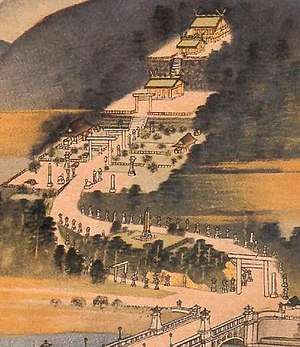Taiwan Grand Shrine
The Taiwan Grand Shrine (traditional Chinese: 臺灣神宮; ; pinyin: Táiwān Shéngōng; Japanese pronunciation: Taiwan Jingū) was the highest ranking Japanese Shinto shrine in Taiwan during Japanese colonial rule. It was located in Taihoku, Taiwan (now Zhongshan District, Taipei). Among the officially sanctioned Shinto shrines in Taiwan, Taiwan Grand Shrine held the highest rank of them all. The Grand Hotel stands at the shrine's former site.

History

Following the death of Prince Yoshihisa in 1895, the Governor-General of Taiwan Nogi Maresuke began planning for a shrine in Yoshihisa's honor. Originally, the plan was to construct the shrine at Yuanshan Park (Chinese: 圓山公園, now part of Taipei Expo Park); however, Nogi's successor Kodama Gentarō and chief planner Gotō Shinpei decided to move it across the Keelung River to Jiantan Mountain (Chinese: 劍潭山) for the site's higher elevation. The vantage point would allow the shrine to overlook the entire city, making it symbolic for the Japanese Empire's colonial power.[1][2] The construction lasted between 1900 and 1901, and the completed shrine was dedicated to Yoshihisa and the Kaitaku Sanjin (開拓三神, Three Kami Deities of Pioneering).[3]
In 1915, a railway station named Miyanoshita Station (宮ノ下乘降場, now Jiantan metro station) was placed at the foot of Jiantan Mountain to serve the shrine.[1] On April 12, 1923, Crown Prince Hirohito, who would become Emperor Shōwa three years later, embarked on a two-week tour of Taiwan. In preparation for his visit to the shrine, Chokushi Road (勅使街道, Chokushi kaidō, present-day Chungshan North Road) was created leading up to the shrine from the city, with the Meiji Bridge (明治橋) crossing the Keelung River.[4]
The shrine was elevated in rank to Grand Shrine (jingū} in 1944 (Shōwa 19) when Amaterasu was enshrined, making it the highest-ranking shrine in Taiwan.[3] The opening ceremony of the new shrine was planned to be on October 28. However, on October 23, 1944, a cargo plane lost control and crashed atop the mountain where the Taiwan Grand Shrine was located, heavily damaging roughly half of the shrine.[5] The shrine was never fully repaired due to Japan's surrender after World War II, and much of the shrine's materials were taken for construction projects elsewhere. In its place, the Grand Hotel was constructed in 1952, where it remains as a prominent landmark of the city.[3]
See also
- Shintoism in Taiwan
- List of Shinto shrines in Taiwan
References
- 李東明. "宮之下 - 台灣神社下的火車站". 永遠的北淡線 (in Chinese). 玉山社. pp. 88–90. ISBN 957-8246-32-3.
- "第四章 日治時期臺灣各級神社的選址與設域的空間特性" (PDF) (in Chinese). National Taiwan Normal University: 137–140. Retrieved May 31, 2020. Cite journal requires
|journal=(help) - 許書維. "臺灣神社誌". 國史館臺灣文獻館 (in Chinese). Retrieved May 31, 2020.
- 一流人 (February 21, 2020). "我們住在「中國的地圖」裡?台北路名藏著滿滿的台灣過往". 遠見 (in Chinese). 天下文化. Retrieved May 31, 2020.
- 郭俊麟. "淺談臺灣今昔地圖與歷史航照在中學地理資訊教育的意義". GIS 教育推廣 電子報 (in Chinese). National Taiwan University. Retrieved May 31, 2020.